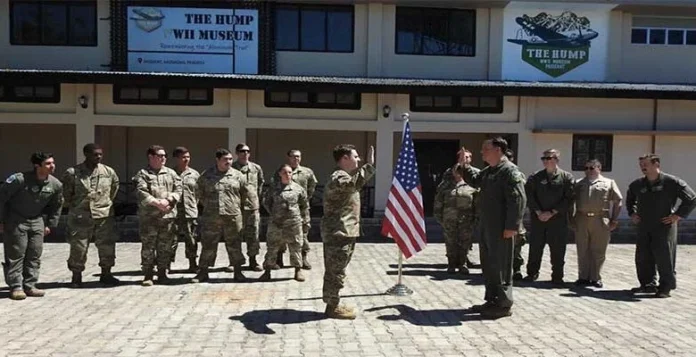In a moving ceremony at the Hump Museum in Pasighat, Arunachal Pradesh, the United States Air Force honoured the memory of American airmen who lost their lives flying the perilous air route known as “The Hump” during World War II. This historic airlift route was a critical supply line between India and China, stretching over the formidable Himalayan Mountains, and was used extensively by Allied forces between 1942 and 1945.
The event marked a major moment of remembrance and respect, as military personnel and dignitaries from both nations gathered to acknowledge the bravery and sacrifice of those who perished during these missions.
The Hump: A Treacherous Air Route
The Hump refers to the Eastern Himalayan mountain range that Allied pilots navigated during World War II to transport essential supplies from India to China. This treacherous route was fraught with numerous hazards, including unpredictable weather conditions, towering mountains, and the constant threat of enemy fire from Japanese forces. The nickname “The Hump” encapsulates the perilous nature of flying over this region.
The air route was established as part of the efforts to support the Chinese forces in their fight against Japan, especially after the Japanese captured Burma (now Myanmar) in 1942, cutting off ground supply routes. The US Air Force played a crucial role in keeping supply lines open through the air, transporting everything from military supplies to food and medicine.
Commemorating the Fallen Airmen
The ceremony at the Hump Museum in Pasighat, a town that holds a special place in World War II history, was attended by high-ranking officers of the US Air Force as well as Indian officials. It served as a poignant reminder of the lives lost during these perilous missions.
More than 1,500 American airmen died while flying missions over the Himalayas, with many aircrafts being lost due to extreme weather, challenging terrain, and lack of navigational aids. The ceremony included the laying of wreaths, the playing of the Last Post, and speeches highlighting the courage and sacrifices made by these soldiers.
Colonel John Matthews, representing the US Air Force, expressed deep admiration for the pilots who risked their lives to complete their missions. He noted that the sacrifices made during World War II laid the foundation for the strong military and diplomatic ties between India and the United States that exist today.
The Hump Museum in Pasighat
The Hump Museum in Pasighat is a testament to the brave airmen who flew over the Himalayas during World War II. It houses various artifacts from the era, including wreckage from planes that crashed while navigating the dangerous terrain. The museum offers visitors a glimpse into the historical significance of the air route and the heroic efforts of those who ensured supplies continued to flow despite the odds.
Established to preserve the memory of these brave airmen, the museum has become a symbol of international collaboration and the sacrifices made during a crucial time in global history. The museum’s collection includes photographs, personal belongings of the airmen, and fragments of downed aircraft recovered from remote parts of the Himalayas.
India-US Military Ties
The commemoration at Pasighat comes at a time when military cooperation between India and the United States continues to grow. The historical event underscores the shared history and strong ties between the two nations, particularly in areas of defense and security cooperation.
Since World War II, both nations have worked together on various fronts, from joint military exercises to defense procurement and strategic partnerships. The annual commemoration of the Hump airmen serves as a reminder of the shared history and enduring friendship between the two countries.
The US and Indian armed forces frequently collaborate on training and strategic initiatives, strengthening the defense partnership in an increasingly interconnected world. The US Air Force’s tribute to the fallen soldiers in Pasighat highlights not only the historical connections between the two nations but also the ongoing commitment to mutual respect and cooperation.
The tribute to fallen airmen at the Hump Museum in Pasighat serves as a powerful reminder of the shared sacrifices made by American and Allied soldiers during World War II. The ceremony highlighted the bravery of the airmen who risked everything to ensure that supply routes over the treacherous Himalayan mountains remained open.
As the US Air Force and Indian officials stood together in remembrance, it was a poignant symbol of the lasting bond between the two countries—one that continues to grow stronger with each passing year. The memory of the Hump airmen remains alive through such ceremonies, keeping the stories of their heroism and sacrifice alive for future generations.
The event in Pasighat not only celebrated the historical connections between India and the US but also strengthened their modern-day strategic and military ties, reaffirming the importance of honoring the past while working towards a secure and prosperous future.




